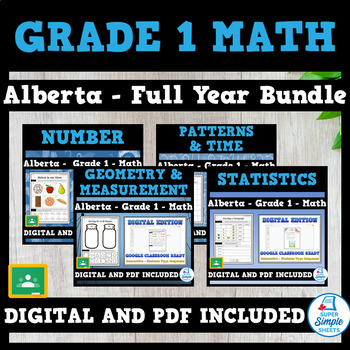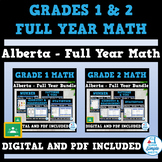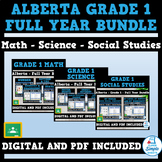Grade 1 - Alberta Math - Full Year Bundle - NEW 2022 Curriculum
- Zip
- Google Apps™

What educators are saying
Products in this Bundle (4)
Also included in
- UPDATED! New 2022 Alberta Math Curriculum – This resource covers all outcomes in the Grades 1 & 2 - NEW Alberta Math Curriculum. NO PREP - JUST PRINT! Perfect for distance teaching, simply send students a PDF copy of the worksheet. Perfect for split grade teaching!Check out each of the strands bPrice $70.00Original Price $88.00Save $18.00
- NEWLY UPDATED FOR THE 2022 AND 2023 CURRICULUMS! BOTH PDF AND GOOGLE SLIDES VERSIONS INCLUDED!FULL YEAR BUNDLE - Teaching made easy! This NO PREP - PDF/GOOGLE SLIDES VERSION bundle includes everything you need to teach Math, Science and Social Studies. It covers all the expectations in the Alberta cPrice $70.00Original Price $88.00Save $18.00
Description
NEWLY UPDATED FOR THE 2022 CURRICULUM! BOTH GOOGLE SLIDES AND PDF VERSIONS ARE INCLUDED!
Grade 1 - Alberta New 2022 Math Curriculum – This resource covers all outcomes in the Grade 1 - Alberta New Math Curriculum. NO PREP - JUST PRINT! Using this resource will ensure that your students will be learning the new curriculum. We have studied the curriculum so that you can focus on delivering the content as opposed to creating materials.
Check out each of the strands below to learn more about the resources included in this bundle.
Strand 1 - Number (Number Sense)
Concepts that are covered:
- Represent quantities using words, numerals, objects, or pictures.
- Identify a quantity of 0 in familiar situations.
- Count within 100, forward by 1s, starting at any number, according to the counting principles.
- Count backward from 20 to 0 by 1s.
- Skip count to 100, forward by 5s and 10s, starting at 0.
- Skip count to 20, forward by 2s, starting at 0. .
- Partition a set of objects by sharing and grouping.
- Demonstrate conservation of number when sharing or grouping.
- Recognize quantities to 10.
- Investigate equal and unequal quantities, including using a balance model.
- Identify numbers that are one more, two more, one less, and two less than a given number.
- Represent a quantity relative to another, including symbolically.
- Visualize quantities between 10 and 20 as compositions of 10 and another quantity.
- Model addition and subtraction within 20 in various ways, including with a balance.
- Relate addition and subtraction to various contexts involving composition or decomposition of quantity.
- Investigate addition and subtraction strategies.
- Add and subtract within 20.
- Check differences and sums using inverse operations.
- Determine a missing quantity in a sum or difference, within 20, in a variety of ways.
- Express addition and subtraction symbolically.
- Solve problems using addition and subtraction
- Identify patterns in addition and subtraction, including patterns in addition tables.
- Recognize families of related addition and subtraction number facts.
- Recall addition number facts, with addends to 10, and related subtraction number facts.
- Identify one-half in familiar situations.
- Partition an even set of objects into two equal groups, limited to sets of 10 or less.
- Partition a shape or object into two equal pieces.
- Describe one of two equal groups or pieces as one-half.
- Verify that the two halves of one whole group, shape, or object are the same size.
Strand 2 - Patterns and Time
Some of the concepts that are covered:
- Repeating patterns are cycles
- Daily cycles in our lives
- Life cycles of a plant, frog, and butterfly
- Métis Seasonal Cycles – what activities they do in each season
- Lunar/Moon Cycles
- How the Indigenous used Moon Cycles
- Seasonal cycles – what activities we do in each season
- Repeating patterns (different shapes, sizes, colours, orientations)
- A/B/C/D patterns with up to 4 elements
- Describing, extending, comparing and creating repeating patterns
- Translating one repeating pattern into another version using the same pattern
- Creating unique patterns using different A/B/C/D cores
- Pattern Cores
- Describe time as a cycle
- Describe the changes we see in time – day/night, seasons
- Reading a calendar
- Days, weeks, months, and years
- 2 Unit Tests – Patterns and Time
- Answer pages for all activities
Strand 3 - Geometry and Measurement
Some of the concepts that are covered:
- Two-dimensional shapes versus three-dimensional shapes
- Familiar two-dimensional shapes – circles, squares, rectangles, and triangles
- Composing and decomposing two- or three-dimensional composite shapes
- Tangram activities – combining shapes
- Lines of symmetry
- Folding two-dimensional shapes to check for symmetry
- Congruent shapes
- Familiar three-dimensional shapes – cubes, prisms, cylinders, spheres, pyramids, cones
- Comparing the length of 2D shapes
- Label the height, width, and depth of objects
- Use vocabulary – taller, wider, deeper
- Compare and order objects by their length
- Describe distances using appropriate vocabulary
- Compare the area, and capacity of objects
- Order objects according to their area and capacity
- Use a third object to compare objects by length, area, and capacity
- Multiple unit tests
Strand 4 - Statistics
Some of the concepts that are covered:
- Create questions about their wonderings
- Format questions so they can survey their classmates
- Gather data from their classmates
- Perform a survey – yes/no questions
- Using tally charts
- Counting tally marks
- Reading concrete graphs
- Creating concrete graphs
- Reading pictographs
- Creating pictographs from concrete graphs
- Ordering data from greatest to least frequency and least to greatest
- Unit test
This is a comprehensive unit that will save you hours of planning! It has been tested and found effective in helping students achieve the learning goals setup by the Ministry of Education in their math curriculum.
Follow Super Simple Sheets for more resources like this one!




